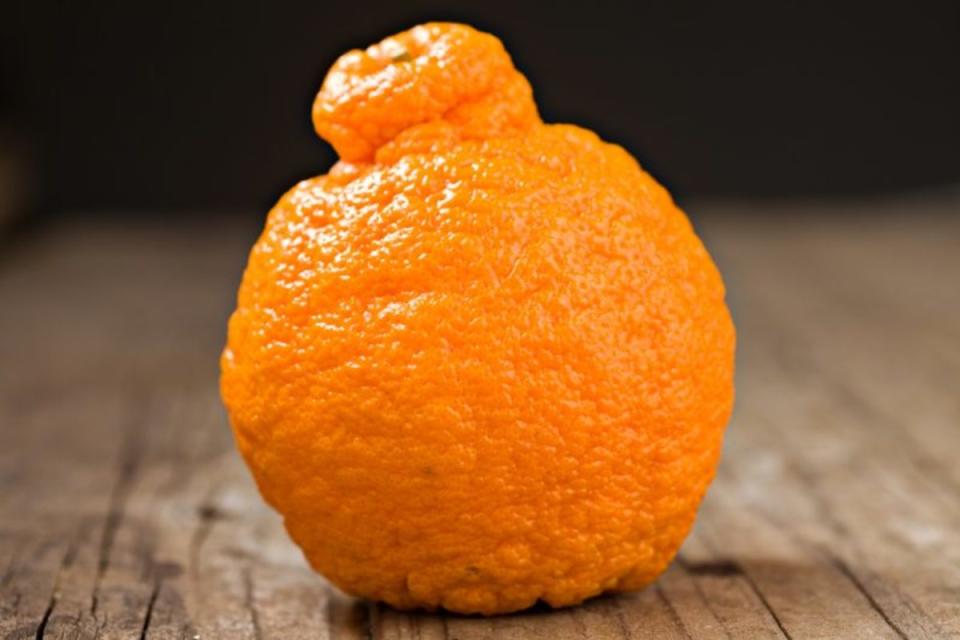What the Heck Is a Sumo Citrus and How Do You Eat It?

Fresh Raw Sumo Oranges Ready to Eat
"Don't call it an orange." The Sumo Citrus, AKA the world's most anticipated fruit, is getting ready for another season of glory—and outshining regular old oranges—come January 2024. So run, don't walk to your local Trader Joe's to stock up on your own juicy haul.
A Sumo orange basically looks like a very large, wrinkled orange with a cute bun at the stem, but there is so much more to the coveted orange.
Related: What the Heck is a Kiwano Melon and How Do You Eat It?
People often comment about the superior level of juiciness contained in Sumo oranges, how easy they are to peel and then there's the price... While they don't come cheap, they are totally worth it, and here's why.
What Is Sumo Citrus?
Sumo Citrus are also known as "dekopon," which is a Japanese reference to the distinctive top knot of the fruit. They are a hybrid citrus fruit which are a cross-breed of Navel, Pomelo and Mandarin oranges. The Sumo Citrus was developed in Japan in 1972 with traditional plant-breeding techniques, but California farmers started growing them in the late 1990s. Technically the Sumo Citrus didn't become available to the public until around 2011, since the trees take years to start bearing fruit.

iStock
What Does the Name Sumo Citrus Mean?
When farmers in California started to grow the seedless fruit they trademarked the name "Sumo Citrus." The name obviously plays on the physical characteristics of the well-known sumo wrestlers in Japan, because these non-oranges are larger in size, round in shape and instantly recognized by their top knot accent, which is the signature hairstyle of the wrestlers.
Related: What the Heck Is a Rambutan and How Do You Eat It?
What Does Sumo Citrus Taste Like?
According to the brand's website, SumoCitrus.com, the Sumo Citrus taste is described as "an intense sweetness balanced by refreshing acidity, and a complex, lingering mandarin orange aroma." So basically better than an orange, times a hundred? Consider our interest piqued.
How Do You Eat Sumo Citrus?
The seedless fruit is easy to peel (and eat) as segments, which makes them convenient for little hands or anyone who finds it tedious to peel an orange. One Sumo Citrus is the equivalent of eating a few mandarin oranges, so you will get a healthy serving of fiber, calcium and vitamin C delivered in one fruit. Sumo Citrus are also low in acidity, which makes them a good choice for people who can't tolerate a higher level of acid in fruit.
View the original article to see embedded media.
Why Is Sumo Citrus So Expensive?
Sumo Citrus trees are difficult to grow and require four years before any fruit can be harvested. The fruit may appear rugged to the touch, but this delicate fruit requires expertise and gentle handling—more than any other piece of citrus. Every single tree is carefully tended to and after the fruit is picked, they even have special trailers that transport them to ensure a stable ride without wear and tear to the fruit! Case in point: They aren't around for a long period of time, so take advantage of their seasonality and treat yourself to this unusual and delicious treat—at an average cost of $3.99/lb at Whole Foods or on FreshDirect.com.
Related: 19 Delicious Sweet and Savory Orange Recipes
When Is Sumo Citrus Season?
The window of time for when Sumo Citrus is available (and at its prime) is limited. These distinctive fruits will begin to appear in markets in January and be available through the end of April, depending on how long supplies last. And judging by the growing interest in them lately, you better get 'em while you can!
PS, when you do get your hands on the small (but mighty) Sumo Citrus, store them in a cool place with good air circulation. They can last for a while unless you get the urge to coat them in chocolate, which also looks like a delish idea:
View the original article to see embedded media.
Up next: Bronze-Cut Pasta Is More Expensive Than Regular Dried Pasta, But Is It Worth It?

